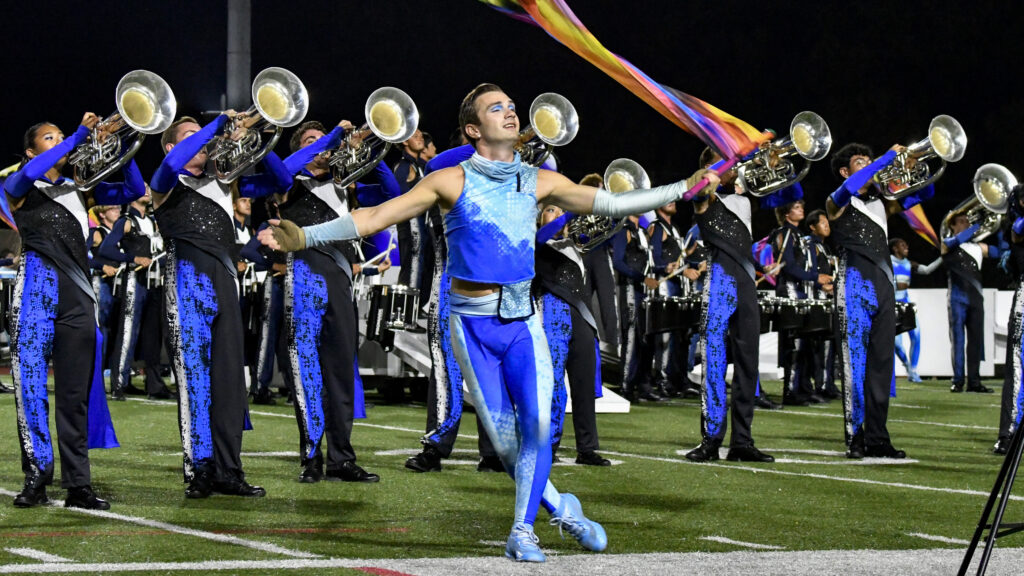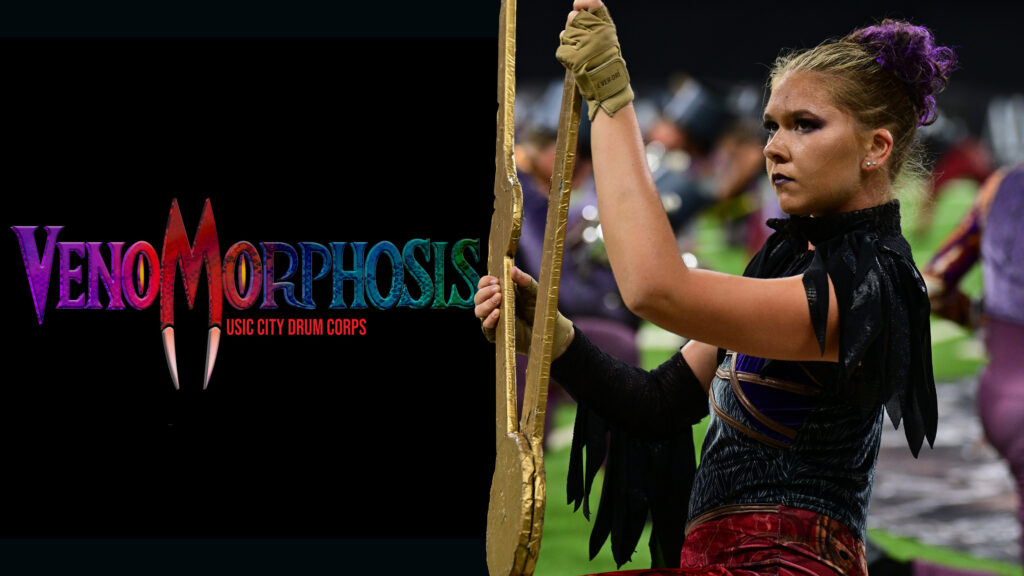In 1995, Santa Clara Vanguard went outside the box.
Throughout much of the 1980s and 1990s, the California corps’ niche was storytelling.
There was a pair of “Phantom of the Opera” programs in 1988 and 1989. There were retellings of “Miss Saigon” and “Fiddler on the Roof” in 1991 and 1992.
As such, the 1995 decision to break out Pyotr Ilyich Tchaikovsky’s well-known ballet, “The Nutcracker,” wasn’t that much of a far cry.
But unlike many of the previous productions, Vanguard’s “Not the Nutcracker” wouldn’t be a direct retelling of the familiar tale, instead choosing to bring the show to life with a sense of whimsy and creative license.
As described in the 1995 DCI Souvenir Yearbook, the corps’ interpretation of the classic ballet was intended to be “unlike any version ever witnessed.” The corps utilized the classic dreamscape setting of “The Nutcracker,” but gave it a post-modern take, bringing audience members along on the journey from reality to fantasy.
And in order to fully unpack its abstract adaptation, Vanguard show designers utilized lesser-known titles and themes from the Tchaikovsky ballet.
“At times, Tchaikovsky’s music is recognizable,” the program notes mentioned. “And at times, it isn’t.”

1995 Santa Clara Vanguard | “Not the Nutcracker”
6th place, 91.900
Santa Clara Vanguard’s 1995 production began with a hypnosis of sorts.
Its corps proper dressed in classic red tops, white pants, and black aussie hats, its drum major donning green, and its color guard dressed in dark gowns, the Northern California corps began the show spread out in diagonals of various angles across the football field.
Centered at midfield, though, were a series of spinning props displaying black and white spirals, seeming to lull the audience into a trance; into “Not the Nutcracker.”
In an opening movement which the corps titled, “The Magical Spell Begins,” wood block quarter notes and chaotic brass swells of recognizable themes from “Dance of the Sugar Plum Fairy” built through an accelerando to a loud, dissonant opening impact chord, which was overlaid by the sound of a siren.

From there, music from “The Nutcracker,” titled, “Departure of the Guests,” led toward a much more pleasing opening statement, which quickly devolved into further dissonance.
“War of the Nuts,” an original work by corps arranger Dave Carico, ensued.
The piece, written with a driving triplet feel, was predicated on staccato impacts, harsh accents and sudden swells, contributing to the sense of “war.” By this point, color guard members had removed the top layer of their costuming, to reveal colorful bodysuits which featured smatterings of yellow, pink and black.
As the piece built and transitioned back into music from “The Nutcracker” — the next source material was pulled from “The Battle” — Vanguard’s brass and percussion sections presented a dazzling drill movement to transition into an energetic percussion feature.
“Elements of good and evil are witnessed in ‘The Battle,’” the corps’ program notes mentioned, “with percussive special effects intensifying the visual clashes of light and dark.”
Members were lined up in four “V”-shaped rows, between the side-one 40-yard line and the 50-yard line. Battery performers were positioned in the center of the formation, while the front “V,” which featured all brass players, opened up in either direction to allow the corps’ drum line to file forward and take center stage.

The percussion feature that followed utilized more music from “The Battle,” and most notably placed a spotlight on the corps’ snare drum line.
During the feature section, Vanguard’s snares — positioned just off the 50-yard line along the front sideline, played a sustained triplet roll accompanied by the steady sound of a wood block, before switching to a series of one-handed tricks.
Snare drummers, utilizing only their right sticks, moved back and forth between their own drums and their neighbors’ for a series of single and double strokes, before connecting on key accented notes to signal the re-entry of the corps’ brass section.
Sections of Vanguard’s horn line traded off feature and melody moments throughout the remainder of this second movement, with periods of intense front ensemble percussion music sprinkled in between. The difficulty of the visual formations written by DCI Hall of Fame member Myron Rosander were at peak levels in this part of Vanguard’s production, as lines of brass and battery percussion players folded through one another with seamless ease.
The tone deceptively grew more positive toward the final portion of the movement, as what seemed to be a high-speed, fanfare-style brass and percussion chorus drove toward a very dissonant finish line, signifying the fitting end of what could be conceived as “Act I” of Vanguard’s 1995 program.
What came next was Santa Clara’s ballad movement titled “Romance and Seduction” borrowing music from the second act of Tchaikovsky’s ballet. This movement featured another iteration of color guard costuming in various colors.
A unique musical characteristic of this third movement was the use of a thongophone in the front ensemble. Many may be most familiar with the tubular percussion instrument’s use by the Blue Man Group. The tall and resonant instrument provided a low, echoing timbre, which coupled well with mysterious brass swells, as the corps played one of the more recognizable selections of the production coming from Act II of the ballet, “Arabian Dance (Coffee).”
While the tone of the brass music remained unchanged throughout this brooding piece, it gradually crescendoed to a short-lived climax, before a sudden fade which further contributed to the mystifying nature of the movement.
Vanguard’s ballad was short, and its transition back into uptempo music was quick. The show’s fourth movement, which was named “Celebration,” took music from “The Nutcracker’s” “Mother Ginger and the Clowns” scene and sped it up, which made for dazzling runs by the front ensemble keyboardists.
Another movement on the short side, “Celebration” fit its name well, returning to a more fanfare-like sound and leading to one of the show’s first truly “major” impact moments.
Fitting to the title of the corps’ final movement, “The Journey Concludes,” Vanguard’s closing moments were generally peaceful and soothing. Another color guard costume change matched the last movement’s tone well, as color guard performers transitioned into clothing and flags that were white like freshly-fallen snow.
“The ultimate passage from one state of being to another is witnessed in ‘The Journey Concludes,’ with a joyful color transformation that can’t be missed,” the corps noted. “With a special effect tying the end into the very beginning of the show, the fascinating finale pays homage to the nature of time.”

In a soundscape that reflected one waking up from a dream, Vanguard utilized soaring music from the scene, “A Pine Forest in Winter,” to slowly build into a resounding final chorus.
Once its lengthy crescendo was completed, Santa Clara Vanguard’s ending was just that — slow, powerful, and uplifting. As strong melodies and chords cascaded, relatively scattered drill formations slowly formed into a company front near the front sideline, which ushered in the show’s compelling last impacts.
And as Vanguard’s production reached its ending, for the first time since the show’s outset, its hypnotic props ceased spinning, signifying the end of a whimsical, entertaining, and innovative dream.
Tchaikovsky VS. Rachmaninoff
Santa Clara Vanguard took a slight step back in terms of competitive placement in 1995, ending up in sixth place after a fifth-place ranking in 1994. The two years prior, though, the corps had earned seventh.
In the corps’ head-to-head meetings in mid-July, Santa Clara hovered about four or five points ahead of Colts, before running into closer competition in late July.
As the season turned toward August, Vanguard found its closest competition from Phantom Regiment’s Rachmaninoff-infused production, “Adventures Under a Darkened Sky.” In the two corps’ first and second head-to-head meetings, July 28 and 29 in Ypsilanti, Michigan, Regiment outscored Vanguard by 1.8 points and 0.7 points respectively.
The two didn’t meet again until the DCI World Championships in Buffalo, New York, where Phantom Regiment fended off Vanguard by an average of about two points across three days of competition. Santa Clara held serve with a substantial lead over Bluecoats, though, to keep hold on sixth place.
Santa Clara Vanguard’s 1995 strength on the scoresheets was in the percussion caption where they placed fifth overall. The corps took sixth and seventh in most other competitive captions and subcaptions.





